Influence of the Porosity of Polymer Foams on the Performances of Capacitive Flexible Pressure Sensors †
Abstract
1. Introduction
2. Sensor Principle
3. PDMS Foam
3.1. Fabrication Process
3.2. Characterization of the PDMS Foams
4. Sensor Electromechanical Characterizations
4.1. Measurement Setup
4.2. Sensor Behavioral Model
4.3. Influence of the Foam (Sugar:PDMS) Ratio
4.4. Influence of the Foam Pore Sizes
4.5. Influence of the Foam Thickness
4.6. Influence of the Dynamics of the Applied Load
5. Conclusions
Author Contributions
Acknowledgments
Conflicts of Interest
References
- Trung, T.Q.; Lee, N.E. Flexible and Stretchable physical sensor integrated platforms for wearable human-activity monitoring and personal healthcare. Adv. Mater. 2016, 28, 4338–4372. [Google Scholar] [CrossRef] [PubMed]
- Lei, K.F.; Lee, K.F.; Lee, M.Y. Development of a flexible PDMS capacitive pressure sensor for plantar pressure measurement. Microelectron. Eng. 2012, 99, 1–5. [Google Scholar] [CrossRef]
- Motha, L.; Kim, J.; Kim, W.S. Instrumented rubber insole for plantar pressure sensing. Org. Electron. Phys. Mater. Appl. 2015, 23, 82–86. [Google Scholar] [CrossRef]
- Schwartz, G.; Tee, B.C.-K.; Mei, J.; Appleton, A.L.; Wang, K.; Bao, Z. Flexible polymer transistors with high pressure sensitivity for application in electronic skin and health monitoring. Nat. Commun. 2013, 4, 1859. [Google Scholar] [CrossRef] [PubMed]
- Khaburi, J.A.; Dehghani-Sanij, A.A.; Nelson, E.A.; Hutchinson, J. Effect of bandage thickness on interface pressure applied by compression bandages. Med. Eng. Phys. 2012, 34, 378–385. [Google Scholar] [CrossRef] [PubMed]
- Huang, Y.; Yuan, H.; Kan, W.; Guo, X.; Liu, C.; Liu, P. A flexible three-axial capacitive tactile sensor with multilayered dielectric for artificial skin applications. Microsyst. Technol. 2017, 23, 1847–1852. [Google Scholar] [CrossRef]
- Surapaneni, R.; Guo, Q.; Xie, Y.; Young, D.J.; Mastrangelo, C.H. A three-axis high-resolution capacitive tactile imager system based on floating comb electrodes. J. Micromech. Microeng. 2013, 23, 75004. [Google Scholar] [CrossRef]
- Viry, L.; Levi, A.; Totaro, M.; Mondini, A.; Mattoli, V.; Mazzoli, B.; Beccai, L. Flexible three-axial force sensor for soft and highly sensitive artificial touch. Adv. Mater. 2014, 26, 2659–2664. [Google Scholar] [CrossRef] [PubMed]
- Tao, L.; Zhang, K.-N.; Tian, H.; Wang, D.-Y.; Chen, Y.-Q.; Yang, Y.; Ren, T.-L. Graphene-Paper pressure sensor for detecting human motions. ACS Nano 2017, 11, 8790–8795. [Google Scholar] [CrossRef] [PubMed]
- Dinh, T.-H.-N.; Martincic, E.; Dufour-Gergam, E.; Joubert, P.-Y. Mechanical characterization of PDMS films for the optimization of polymer based flexible capacitive pressure microsensors. J. Sens. 2017, 2017, 8235729. [Google Scholar] [CrossRef]
- Dinh, T.H.N.; Martincic, E.; Dufour-Gergam, E.; Joubert, P.-Y. Capacitive flexible pressure sensor: microfabrication process and experimental characterization. Microsyst. Technol. 2016, 22, 465–471. [Google Scholar] [CrossRef]
- Dobrzynska, J.A.; Gijs, M.A.M. Polymer-based flexible capacitive sensor for three-axial force measurements. J. Micromech. Microeng. 2013, 23, 015009. [Google Scholar] [CrossRef]
- Mitrakos, V.; Macintyre, L.; Denison, F.C.; Hands, P.J.W.; Desmulliez, M.P.Y. Design, manufacture and testing of capacitive pressure sensors for low-pressure measurement ranges. Micromachines 2017, 8, 1–10. [Google Scholar] [CrossRef]
- Xu, F.; Li, X.; Shi, Y.; Li, L.; Wang, W.; He, L.; Liu, R. Recent Developments for flexible pressure sensors: A Review. Micromachines 2018, 9, 1–17. [Google Scholar] [CrossRef]
- Mannsfeld, S.C.B.; Tee, B.C.-K.; Stolenberg, R.M.; Chen, C.V.H.-H.; Barman, S.; Muir, B.V.O.; Sokolov, A.N.; Reese, C.; Bao, Z. Highly sensitive flexible pressure sensors with microstructured rubber dielectric layers. Nat. Mater. 2010, 9, 859–864. [Google Scholar] [CrossRef] [PubMed]
- Yoon, J.L.; Choi, K.S.; Chang, S.P. A novel means of fabricating microporous structures for the dielectric layers of capacitive pressure sensor. Microelectron. Eng. 2017, 179, 60–66. [Google Scholar] [CrossRef]
- Chhetry, A.; Yoon, H.; Park, J.Y. A flexible and highly sensitive capacitive pressure sensor based on conductive fibers with a microporous dielectric for wearable electronics. J. Mater. Chem. C 2017, 5, 10068–10076. [Google Scholar] [CrossRef]
- Kwon, D.; Lee, T.; Kim, M.S.; Kim, S.T.; Kim, S.; Park, I. Porous dielectric elastomer based ultra-sensitive capacitive pressure sensor and its application to wearable sensing device. Transducers 2015, 2015, 299–302. [Google Scholar]
- Mark, J.E. Polymer Data Handbook; Oxford University Press: New York, NY, USA, 1999. [Google Scholar]
- Tsai, P.J.; Nayak, S.; Ghosh, S.; Puri, I.K. Influence of particle arrangement on the permittivity of an elastomeric composite. AIP Adv. 2017, 7, 1–8. [Google Scholar] [CrossRef]
- Johnston, I.D.; McCluskey, D.K.; Tan, C.K.L.; Tracey, M.C. Mechanical characterization of bulk Sylgard 184 for microfluidics and microengineering. J. Micromech. Microeng. 2014, 24, 035017. [Google Scholar] [CrossRef]
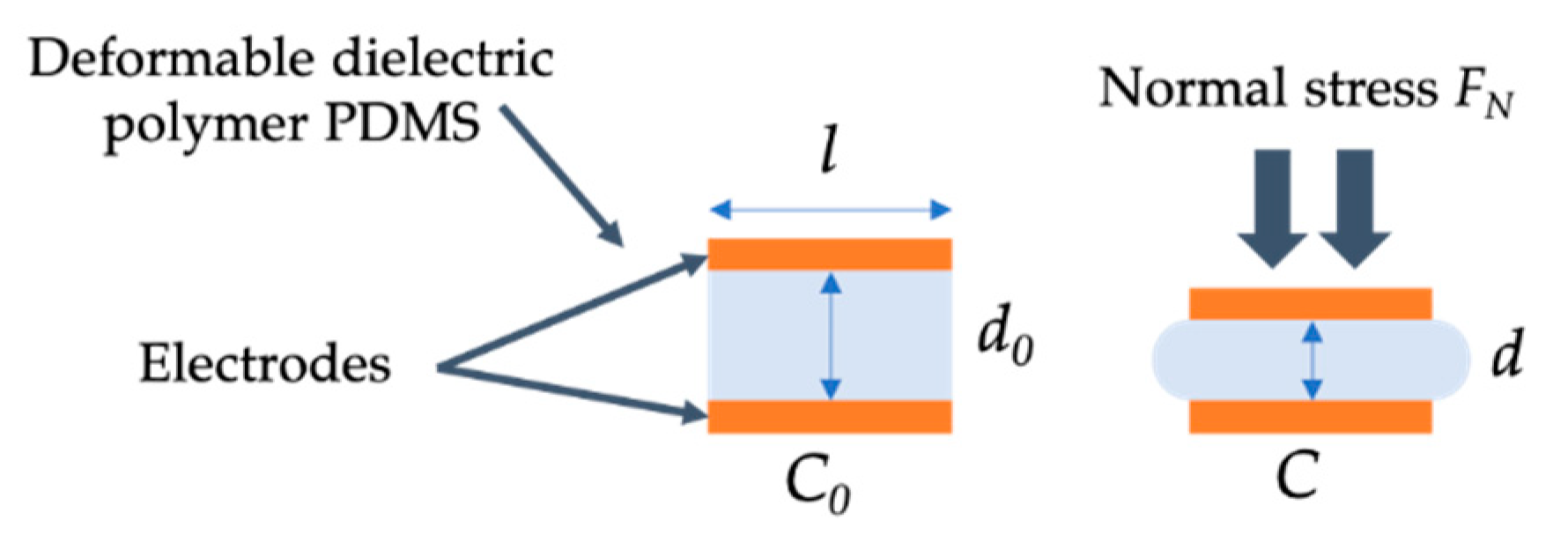
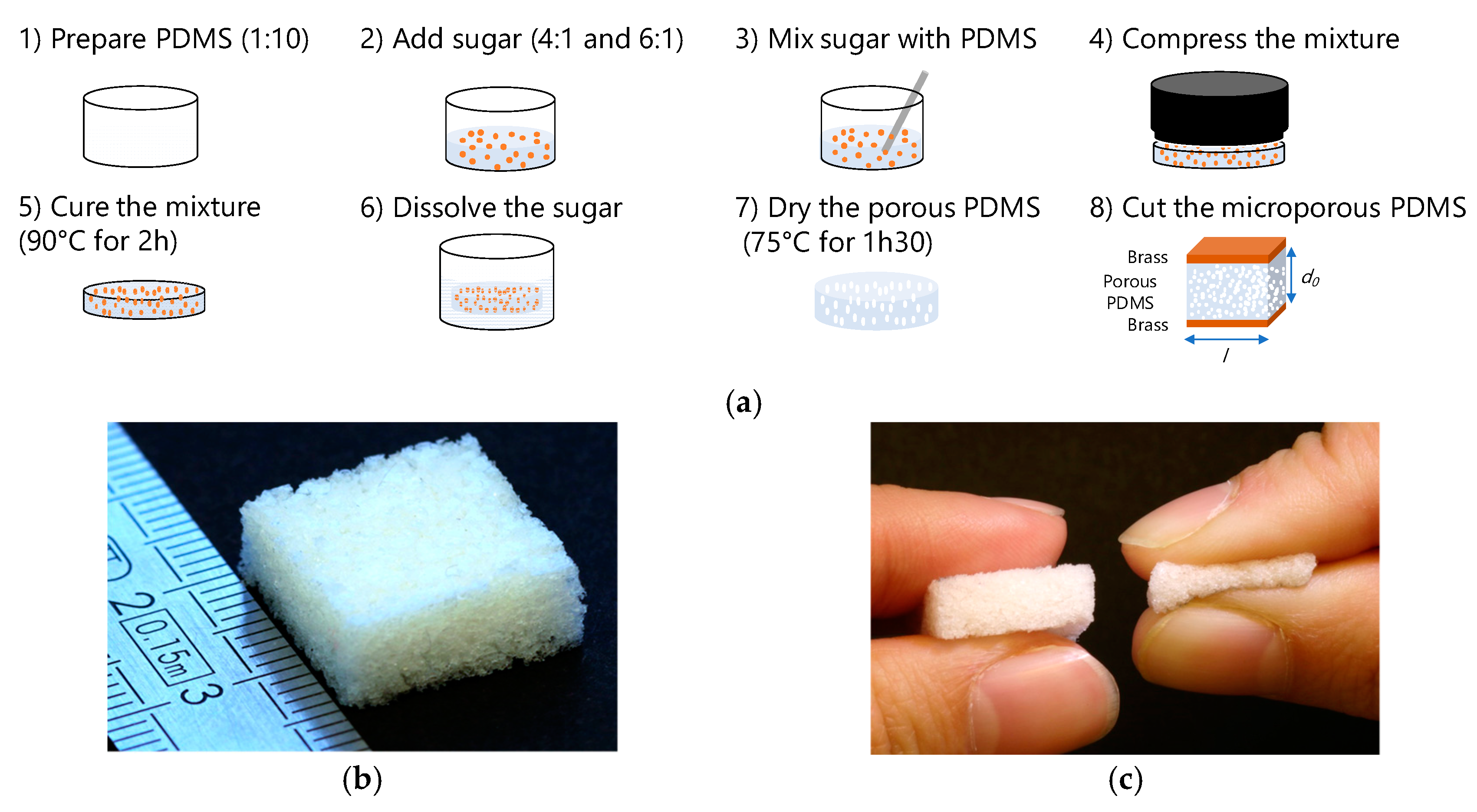
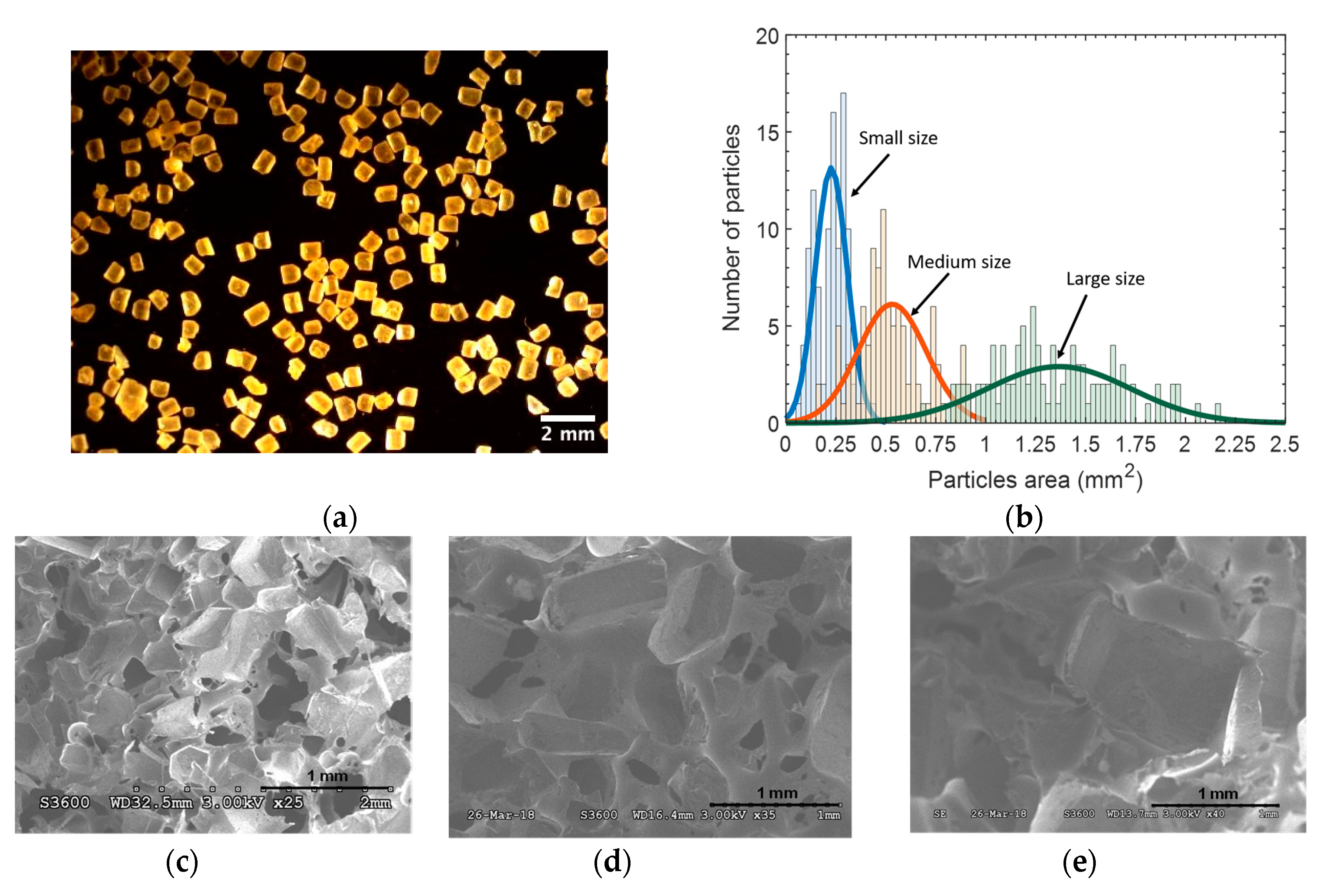
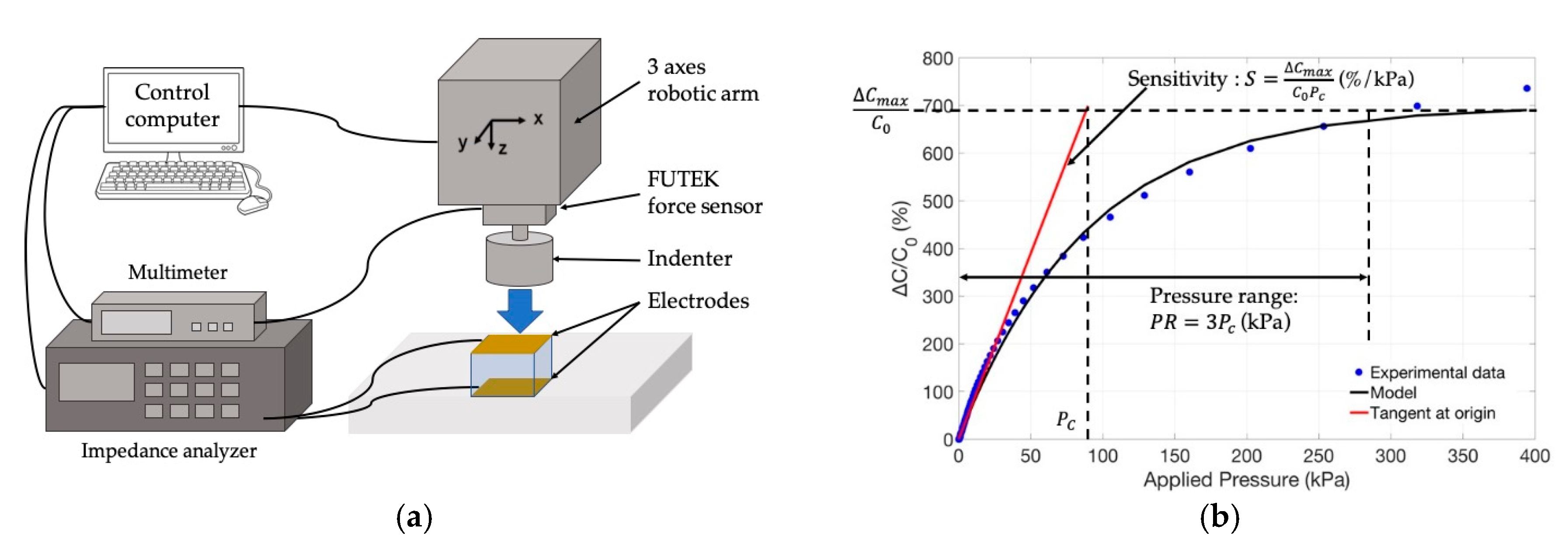
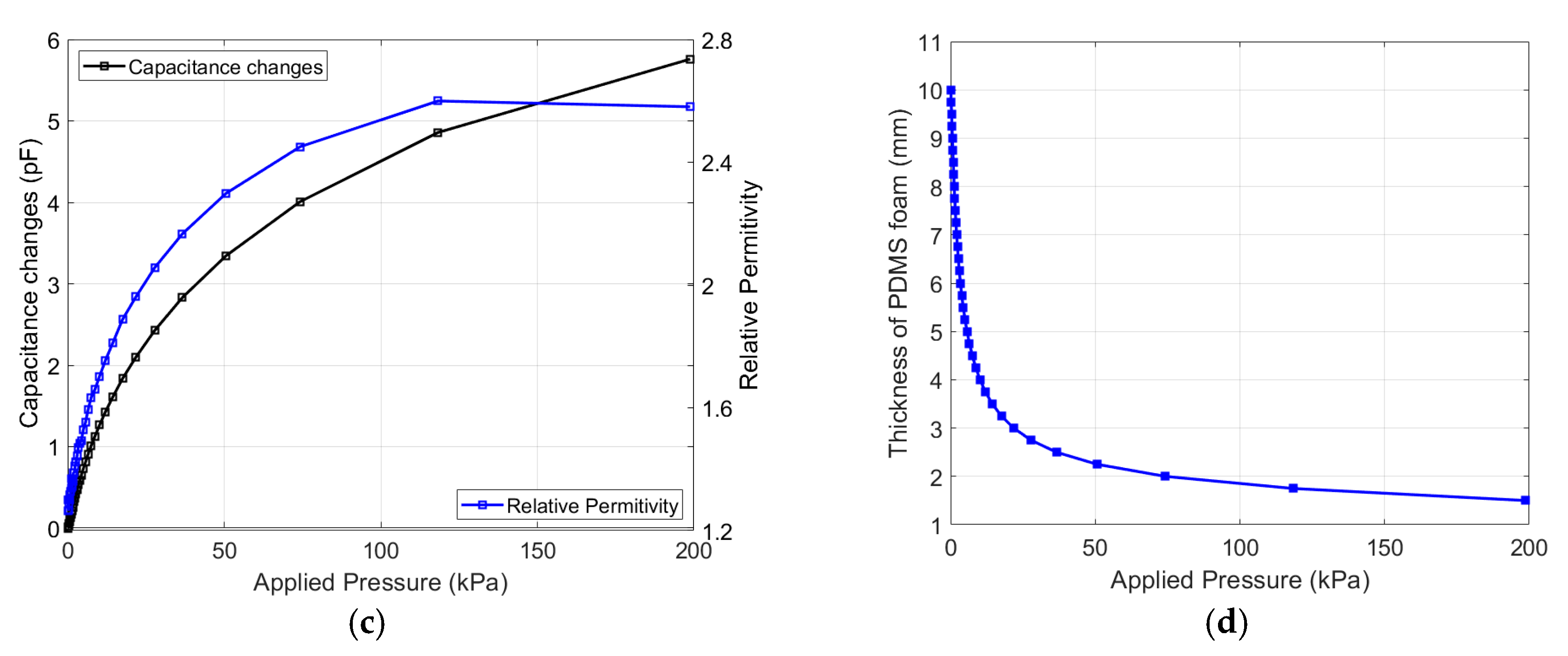
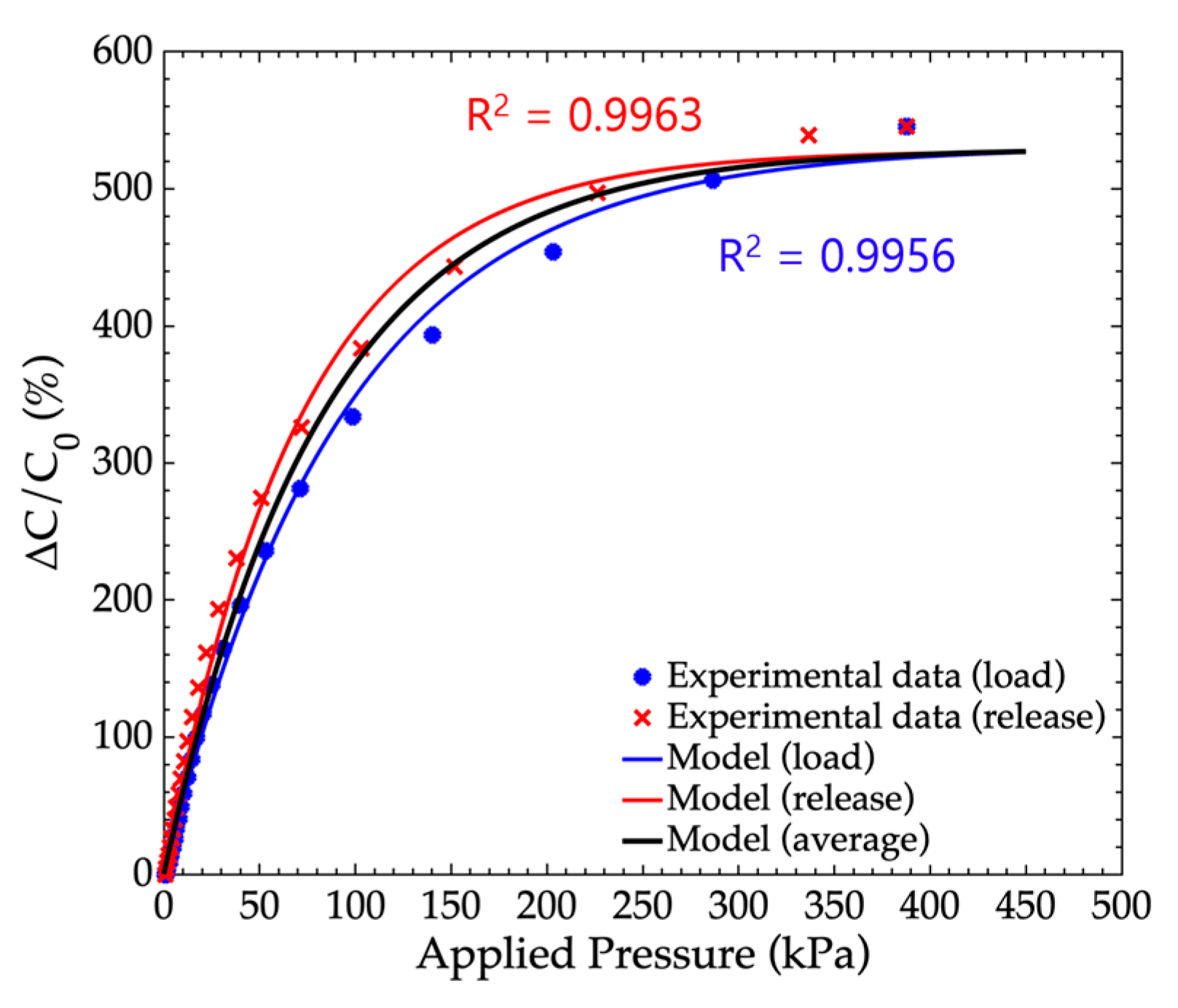
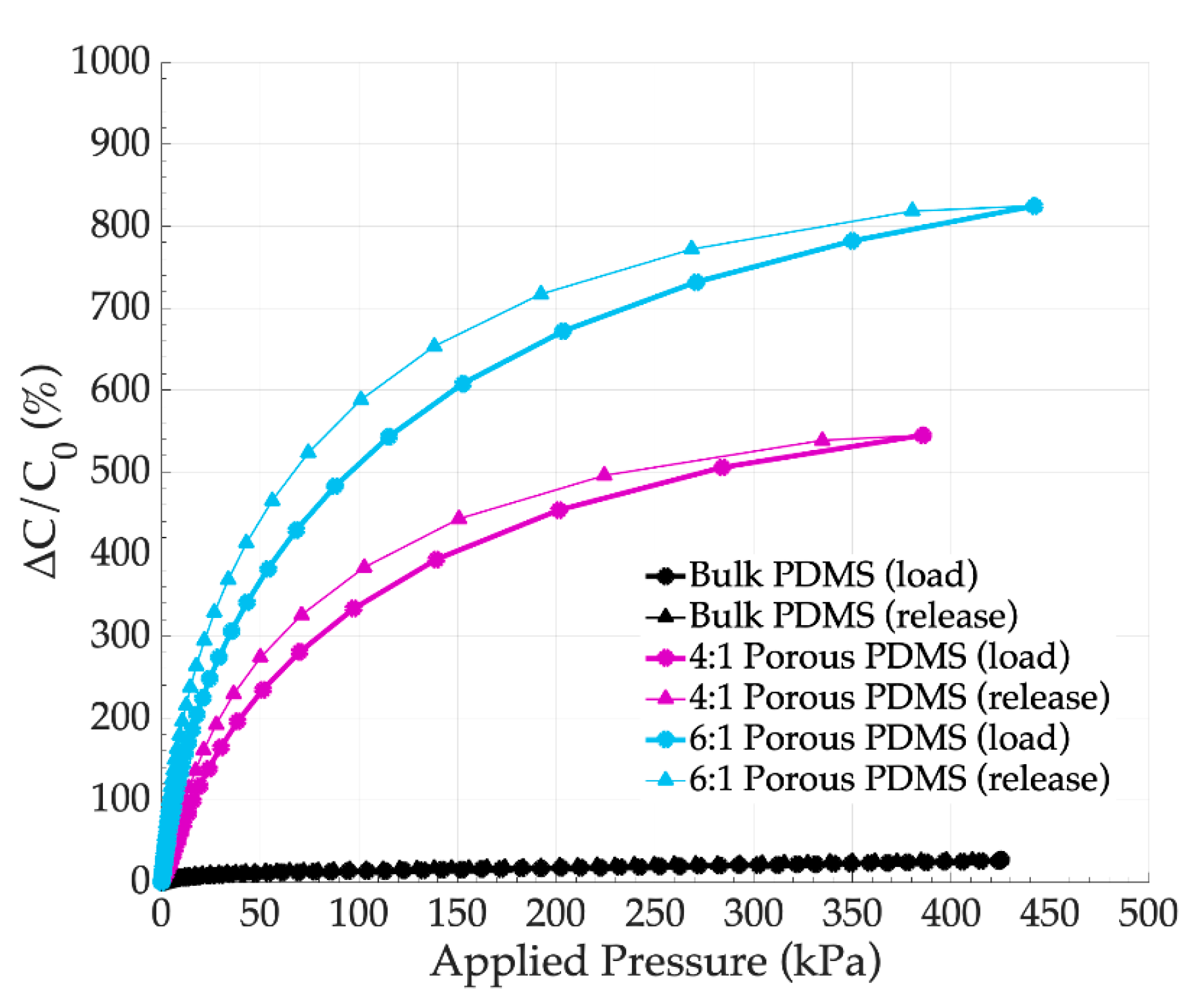

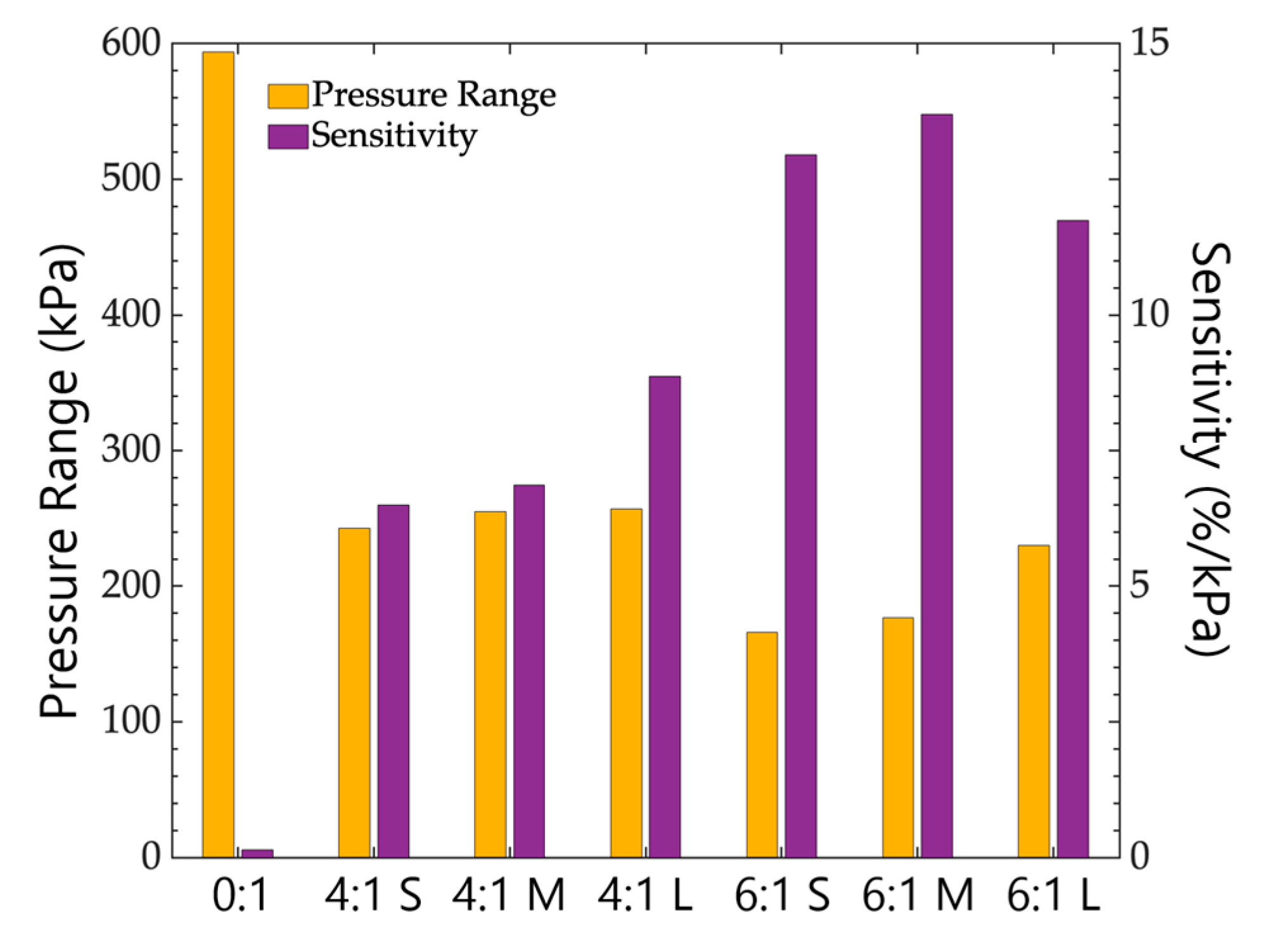
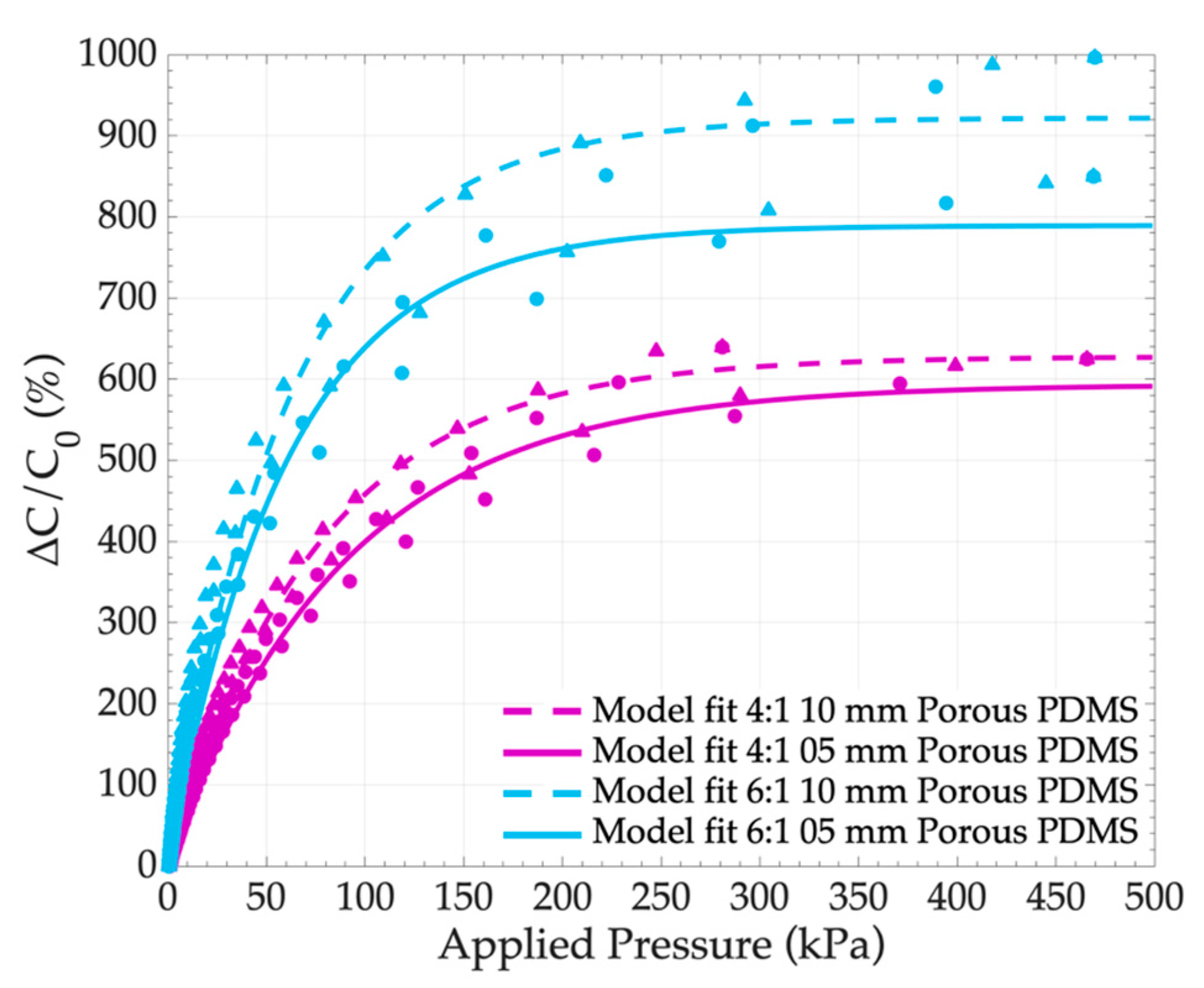
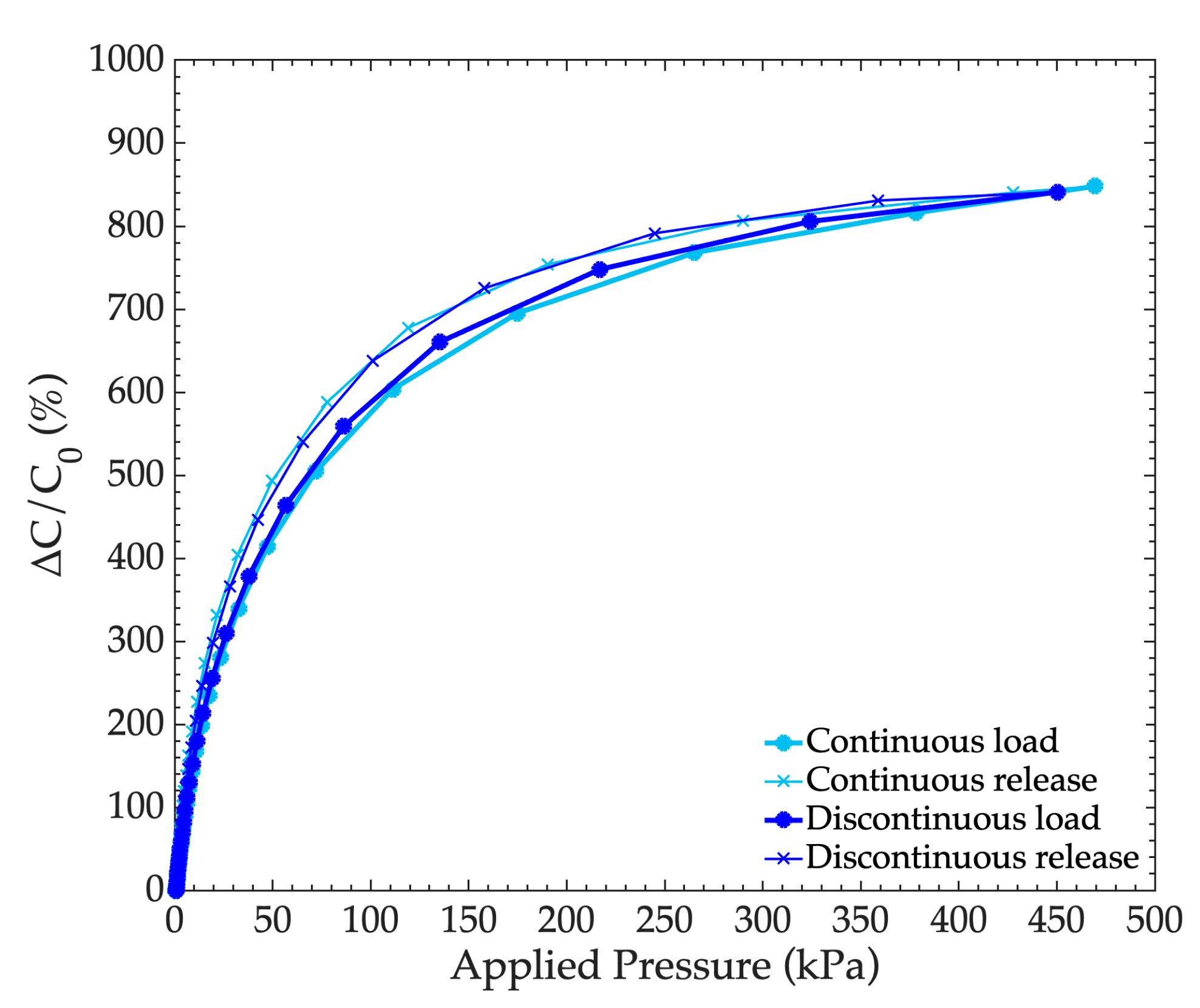
| Volume Ratio Sugar: PDMS | Sizes of Sugar Particles (µm) | Porosity (%) | Theoretical εr | Experimental εr |
|---|---|---|---|---|
| 0:1 (bulk) | No crystal | 0 | 2.69 | 2.67 ± 0.06 |
| 4:1 (foam) | Small: 470 ± 100 | 78.64 ±1.40 | 1.36 | 1.56 ± 0.01 |
| Medium: 700 ± 230 | 80.36 ±1.40 | 1.33 | 1.36 ± 0.06 | |
| Large: 1100 ± 330 | 80.81 ± 1.40 | 1.32 | 1.34 ± 0.01 | |
| 6:1 (foam) | Small: 470 ± 100 | 81.96 ±1.40 | 1.30 | 1.30 ± 0.13 |
| Medium: 700 ± 230 | 84.36 ±1.40 | 1.26 | 1.25 ± 0.07 | |
| Large: 1100 ± 330 | 83.53 ±1.40 | 1.28 | 1.29 ± 0.01 |
| Volume Ratio Sugar: PDMS | Sizes of Sugar Particles | C0 (pF) | PR (kPa) | S (%.kPa−1) | Hysteresis (%) |
|---|---|---|---|---|---|
| 0:1 | Bulk | 1.14 ± 0.02 | 594 | 0.14 | 8.85 |
| 4:1 | Small | 0.89 ± 0.02 | 243 | 6.50 | 5.60 |
| Medium | 0.62 ± 0.02 | 255 | 6.87 | 5.41 | |
| Large | 0.54 ± 0.02 | 257 | 8.85 | 5.31 | |
| 6:1 | Small | 0.82 ± 0.02 | 166 | 12.95 | 6.42 |
| Medium | 0.69 ± 0.02 | 177 | 13.70 | 4.58 | |
| Large | 0.84 ± 0.02 | 230 | 11.74 | 6.62 |
| Volume Ratio Sugar: PDMS | Sizes of Sugar Particles | d0 (mm) | C0 (pF) | PR (kPa) | S (%.kPa−1) | Hysteresis (%) |
|---|---|---|---|---|---|---|
| 4:1 | Medium | 10 | 0.40 ± 0.02 | 221 | 8.32 | 7.22 |
| 5 | 0.62 ± 0.02 | 261 | 6.88 | 5.41 | ||
| 6:1 | Medium | 10 | 0.38 ± 0.02 | 180 | 15.77 | 5.06 |
| 5 | 0.69 ± 0.02 | 177 | 13.70 | 4.58 |
| Volume Ratio Sugar: PDMS | Sizes of Sugar Particles | Applied Load | C0(pF) | PR (kPa) | S (%.kPa−1) | Hysteresis (%) |
|---|---|---|---|---|---|---|
| 6:1 | Medium | Continuously | 0.69 ± 0.02 | 177 | 13.70 | 4.58 |
| Discontinuously | 174 | 13.66 | 2.92 |
© 2019 by the authors. Licensee MDPI, Basel, Switzerland. This article is an open access article distributed under the terms and conditions of the Creative Commons Attribution (CC BY) license (http://creativecommons.org/licenses/by/4.0/).
Share and Cite
Bilent, S.; Dinh, T.H.N.; Martincic, E.; Joubert, P.-Y. Influence of the Porosity of Polymer Foams on the Performances of Capacitive Flexible Pressure Sensors. Sensors 2019, 19, 1968. https://doi.org/10.3390/s19091968
Bilent S, Dinh THN, Martincic E, Joubert P-Y. Influence of the Porosity of Polymer Foams on the Performances of Capacitive Flexible Pressure Sensors. Sensors. 2019; 19(9):1968. https://doi.org/10.3390/s19091968
Chicago/Turabian StyleBilent, Sylvie, Thi Hong Nhung Dinh, Emile Martincic, and Pierre-Yves Joubert. 2019. "Influence of the Porosity of Polymer Foams on the Performances of Capacitive Flexible Pressure Sensors" Sensors 19, no. 9: 1968. https://doi.org/10.3390/s19091968
APA StyleBilent, S., Dinh, T. H. N., Martincic, E., & Joubert, P.-Y. (2019). Influence of the Porosity of Polymer Foams on the Performances of Capacitive Flexible Pressure Sensors. Sensors, 19(9), 1968. https://doi.org/10.3390/s19091968





